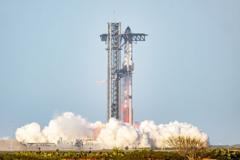The Starship, which towers at 123 meters as the largest rocket ever constructed, remains central to Musk's dream of establishing a human presence on Mars. However, its journey has not been smooth; just last week, a Starship rocket experienced a catastrophic failure shortly after launch from a Texas pad, marking the second such incident this year following another launch explosion in January. This recent mishap resulted in debris being observed descending into the Bahamas, prompting SpaceX to conduct a thorough analysis to determine the underlying causes of the explosion, particularly after suffering engine losses.
The Federal Aviation Administration (FAA) announced that an investigation into the explosive failures is mandatory before further launches can occur. As part of its evolving missions, NASA is eyeing a modified iteration of the Starship for lunar exploration through its Artemis program aimed at returning humans to the Moon.
Musk envisions that the initial Mars expedition will be accompanied by the Tesla humanoid robot named "Optimus," designed to eventually undertake mundane tasks and priced between $20,000 and $30,000. In another development, SpaceX recently launched a Falcon 9 rocket that successfully transported a crew to the International Space Station (ISS), reconnecting with their mission despite previous delays due to technical complications with their spacecraft.
With aspirations of making humanity a multi-planetary species, Musk’s efforts could redefine the future of space exploration.
The Federal Aviation Administration (FAA) announced that an investigation into the explosive failures is mandatory before further launches can occur. As part of its evolving missions, NASA is eyeing a modified iteration of the Starship for lunar exploration through its Artemis program aimed at returning humans to the Moon.
Musk envisions that the initial Mars expedition will be accompanied by the Tesla humanoid robot named "Optimus," designed to eventually undertake mundane tasks and priced between $20,000 and $30,000. In another development, SpaceX recently launched a Falcon 9 rocket that successfully transported a crew to the International Space Station (ISS), reconnecting with their mission despite previous delays due to technical complications with their spacecraft.
With aspirations of making humanity a multi-planetary species, Musk’s efforts could redefine the future of space exploration.




















